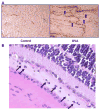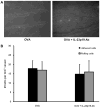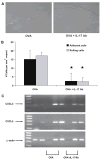Interleukin-17 causes neutrophil mediated inflammation in ovalbumin-induced uveitis in DO11.10 mice
- PMID: 19254849
- PMCID: PMC2745339
- DOI: 10.1016/j.cyto.2008.12.019
Interleukin-17 causes neutrophil mediated inflammation in ovalbumin-induced uveitis in DO11.10 mice
Abstract
T cell-mediated uveitis is strongly associated with many systemic inflammatory disorders. Th17 cells are a novel T cell subset characterized by production of interleukin (IL)-17. In this study, we used DO11.10 mice to investigate the role of IL-17 in the pathogenesis of uveitis. CD4(+) T cells in DO11.10 mice are genetically engineered to react with ovalbumin (OVA). IL-17 expression was determined by real-time PCR and ELISPOT. Uveitis was induced by intravitreal injection of OVA, and ocular inflammation was evaluated by intravital microscopy. OVA challenge significantly induced IL-17 production by DO11.10 splenocytes in vitro. Next, we examined whether OVA challenge could elicit local inflammation and induce IL-17 in vivo. OVA elicited marked neutrophil-predominant inflammatory cell infiltration in the eyes. This leukocyte influx was mediated by CD4(+) lymphocytes as evidenced by significant inhibition of the ocular inflammation by CD4+ depleting antibody. Compared to control mice, OVA treatment induced IL-17 expression. Moreover, anti-IL-17 antibody markedly reduced OVA-mediated ocular inflammation. Finally, the neutralization of IL-17 attenuated ocular expression of CXCL2 and CXCL5, two cytokines which are chemotactic for neutrophils. Our study suggests that IL-17 is implicated in the pathogenesis of this T cell-mediated model of uveitis in part through neutrophil chemotaxis as a downstream effect of IL-17.
Figures












Similar articles
-
CXCR4 but not CXCR7 is mainly implicated in ocular leukocyte trafficking during ovalbumin-induced acute uveitis.Exp Eye Res. 2009 Oct;89(4):522-31. doi: 10.1016/j.exer.2009.05.012. Epub 2009 Jun 12. Exp Eye Res. 2009. PMID: 19524567 Free PMC article.
-
Expression of dual TCR on DO11.10 T cells allows for ovalbumin-induced oral tolerance to prevent T cell-mediated colitis directed against unrelated enteric bacterial antigens.J Immunol. 2004 Feb 1;172(3):1515-23. doi: 10.4049/jimmunol.172.3.1515. J Immunol. 2004. PMID: 14734729
-
Dual TCR expression biases lung inflammation in DO11.10 transgenic mice and promotes neutrophilia via microbiota-induced Th17 differentiation.J Immunol. 2011 Oct 1;187(7):3530-7. doi: 10.4049/jimmunol.1101720. Epub 2011 Aug 22. J Immunol. 2011. PMID: 21859957
-
Rapid up-regulation of CXC chemokines in the airways after Ag-specific CD4+ T cell activation.J Immunol. 2001 Jan 15;166(2):1233-40. doi: 10.4049/jimmunol.166.2.1233. J Immunol. 2001. PMID: 11145706
-
Natural occurring IL-17 producing T cells regulate the initial phase of neutrophil mediated airway responses.J Immunol. 2009 Dec 1;183(11):7523-30. doi: 10.4049/jimmunol.0803828. Epub 2009 Nov 4. J Immunol. 2009. PMID: 19890042
Cited by
-
Type I interferons: beneficial in Th1 and detrimental in Th17 autoimmunity.Clin Rev Allergy Immunol. 2013 Apr;44(2):114-20. doi: 10.1007/s12016-011-8296-5. Clin Rev Allergy Immunol. 2013. PMID: 22231516 Free PMC article. Review.
-
Angiotensin II-induced Hypertension is Reduced by Deficiency of P-selectin Glycoprotein Ligand-1.Sci Rep. 2018 Feb 19;8(1):3223. doi: 10.1038/s41598-018-21588-3. Sci Rep. 2018. PMID: 29459637 Free PMC article.
-
Myelin-specific Th17 cells induce severe relapsing optic neuritis with irreversible loss of retinal ganglion cells in C57BL/6 mice.Mol Vis. 2016 Apr 11;22:332-41. eCollection 2016. Mol Vis. 2016. PMID: 27122964 Free PMC article.
-
Study of the shared gene signatures of polyarticular juvenile idiopathic arthritis and autoimmune uveitis.Front Immunol. 2023 Mar 8;14:1048598. doi: 10.3389/fimmu.2023.1048598. eCollection 2023. Front Immunol. 2023. PMID: 36969183 Free PMC article.
-
CXCR4 but not CXCR7 is mainly implicated in ocular leukocyte trafficking during ovalbumin-induced acute uveitis.Exp Eye Res. 2009 Oct;89(4):522-31. doi: 10.1016/j.exer.2009.05.012. Epub 2009 Jun 12. Exp Eye Res. 2009. PMID: 19524567 Free PMC article.
References
-
- Gritz DC, Wong IG. Incidence and prevalence of uveitis in Northern California; the Northern California Epidemiology of Uveitis Study. Ophthalmology. 2004;111(3):491–500. discussion 500. - PubMed
-
- Nussenblatt RB. The natural history of uveitis. International Ophthalmology. 1990;14(5–6):303–8. - PubMed
-
- Becker MD, Adamus G, Davey MP, Rosenbaum JT. The role of T cells in autoimmune uveitis. Ocular Immunology & Inflammation. 2000;8(2):93–100. - PubMed
-
- Martin TM, Smith JR, Rosenbaum JT. Anterior uveitis: current concepts of pathogenesis and interactions with the spondyloarthropathies. Current Opinion in Rheumatology. 2002;14(4):337–41. - PubMed
-
- Atalla L, Linker-Israeli M, Steinman L, Rao NA. Inhibition of autoimmune uveitis by anti-CD4 antibody. Investigative Ophthalmology & Visual Science. 1990;31(7):1264–70. - PubMed
MeSH terms
Substances
Grants and funding
LinkOut - more resources
Full Text Sources
Other Literature Sources
Research Materials

